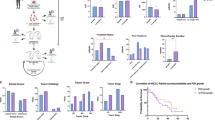Abstract
Leukemic cell growth in SCID mice has been reported as a predictor of disease relapse. However, there is a paucity of literature regarding xenograft growth and clinical outcomes in non-small cell lung cancer (NSCLC). Seventy-nine specimens from patients with NSCLC were either subcutaneously implanted into SCID mice and/or placed in tissue culture. Retrospective chart review was correlated with stage, histology, necrosis, disease-free interval, and survival. Tumor xenografts were successfully established with 17 of 37 (46%) tumor biopsy tissues. Thirteen of 59 (22%) specimens grew in cell culture. Patients whose tumors grew in SCID mice had no difference in survival compared to those with no growth (n=20, p=0.42). Median survival was 36 months in 13 patients whose tumors grew in cell culture compared to 39 months in 46 patients without growth. Eight of 12 (67%) patients with metastasis showed SCID/human xenograft growth, whereas nine of 25 (36%) without metastases did so (p=0.08). Growth of tumor cells in vitro occurred in 11 of 31 (35%) adenocarcinomas, one of 25 (4%) squamous cell carcinomas, and one of three (33%) large cell carcinomas (p=0.02). Well or moderately differentiated tumors grew in cell culture in only two of 22 (9%), whereas poorly or undifferentiated tumors grew in 11 of 32 (34%) cases (p=0.03). We conclude that neither the ability of a tumor to engraft and grow in SCID mice nor its ability to grow in vitro in cell culture is a reliable predictor of disease outcome or survival in patients with NSCLC. The ability to propagate tumors in vitro appears to be more dependent upon the histological type of tumor and its degree of differentiation.
Similar content being viewed by others
References
American Cancer Society (2001) 2000 Cancer facts and figures: selected cancers, vol 2000. American Cancer Society, Atlanta
Mountain CF (1997) Revisions in the international system for staging lung cancer. Chest 11:1710–1717
Mountain CF, Dresler CM (1997) Regional lymph node classification for lung cancer staging. Chest 11:1718–1723
Saunders CAB, Dussek JE, O'Doherty MJ, Maisey MN (1999) Evaluation of fluorine-18-fluorodeoxyglucose whole body positron emission tomography imaging in the staging of lung cancer. Ann Thorac Surg 67:790–797
Beckett WS (1993) Epidemiology and etiology of lung cancer. Clin Chest Med 14:1
Yamada M, Shiroko T, Kawaguchi Y, Sugiyama Y, Egilmez NK, Chen FA, Bankert RB (2001) CD4-CD40 ligand (CD154) engagement is required but not sufficient for modulating MHC class I, ICAM-1 and Fas expression and proliferation of human non-small cell lung tumors. Int J Cancer 92:589–599
Cox DR (1972) Regression models and life-tables. J R Stat Soc B 34:187–220
Kaplan EL, Meier P (1958) Nonparametric estimation from incomplete observations. J Am Stat Assoc 53:457–486
Kamel-Reid S, Letarte M, Sirard C, Doedens M, Grunberger T, Fulop GM, Freedman MH, Phillips RA, Dick JE (1989) A model of human acute lymphoblastic leukemia in immune deficient SCID mice. Science 246:1597
Kamel-Reid S, Letarte M, Doedens M, et al. (1991) Bone marrow from children in relapse with pre-B acute lymphoblastic leukemia proliferates and disseminates rapidly in SCID mice. Blood 78:2973–2981
Uckun FM, Sather H, Reaman G, et al. (1995) Leukemic cell growth in SCID mice as a predictor of relapse in high-risk B-lineage acute lymphoblastic leukemia. Blood 85:873–878
Arenberg DA, Kunkel SL, Polverini PJ, Morris SB, Burdick MD, Glass M, Taub DT, Iannettoni MD, Whyte RI, Strieter RM (1996) Interferon-γ inducible protein 10 (IP-10) is an angiostatic factor that inhibits human non-small cell lung cancer (NSCLC) tumorigenesis and spontaneous metastases. J Exp Med 184:981
Hess SD, Egilmez NK, Bailey N, Anderson TM, Mathiowitz E, Bernstein SH, Bankert RB (2003) Human CD4+ T cells present within the microenvironment of human lung tumors are mobilized by the local and sustained release of IL-12 to kill tumors in situ by indirect effects of IFN-γ. J Immunol 170:400–412
Bankert RB, Egilmez NK, Hess SD (2001) Human-SCID mouse chimeric models for the evaluation of anti-cancer therapies. Trends Immunol 22:386–393
Acknowledgements
We would like to thank Deborah Driscoll for her helpful assistance with the statistical analysis of this manuscript.
Author information
Authors and Affiliations
Corresponding author
Rights and permissions
About this article
Cite this article
Anderson, T.M., Hess, S.D., Egilmez, N.K. et al. Comparison of human lung cancer/SCID mouse tumor xenografts and cell culture growth with patient clinical outcomes. J Cancer Res Clin Oncol 129, 565–568 (2003). https://doi.org/10.1007/s00432-003-0473-3
Received:
Accepted:
Published:
Issue Date:
DOI: https://doi.org/10.1007/s00432-003-0473-3




